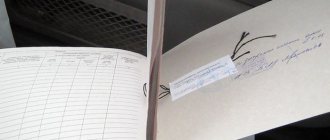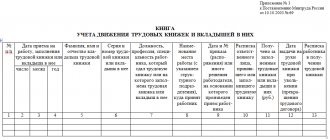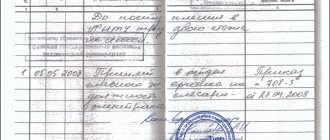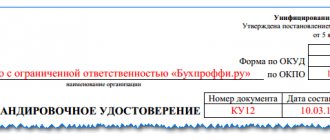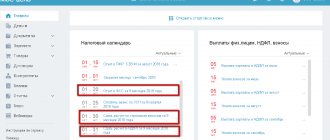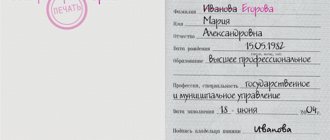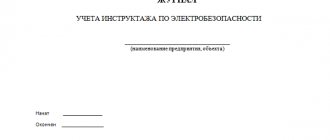Rules of law
A work book is the most important document of an employee, the safety of which is controlled by the employer. By law, if a company has at least one hired employee, it is necessary to keep a log of work records. This is a legal requirement, which is stated in the rules for maintaining and storing TC. Moreover, such a record book must be sealed in accordance with the law. This is a document of increased accountability, therefore, its appearance and sealing, in particular, should be treated with extreme care. This measure helps protect the journal from external interference in order to make adjustments to existing records.
Sealing (protection) of the work record book is an important aspect of the HR officer’s activity. This document is always checked during scheduled visits by specialists from the State Labor Inspectorate. Disadvantages in the design of such forms are discovered very often.
There are certain requirements regarding the appearance and size of the magazine, including:
- The book must be in A-4 format.
- Its volume (number of sheets) should be such that it is enough for at least 2-3 years.
- Thick cover. It is needed because the work record book is used for a long period, and is stored in the archive for even longer.
- The layout of the pages should be such that all the necessary data can be entered.
Other important requirements for the book of accounting for the movement of work books and inserts in them:
- The journal must be signed personally by the manager.
- Each sheet is hand numbered by an authorized employee.
- The book must be stitched and sealed.
If at least one of these requirements is not met, this will lead to the imposition of penalties on the employer.
How to properly stitch and seal a logbook for recording the movement of work books
The title page of the magazine is filled out by a personnel officer or other responsible employee, who is appointed by the director of the organization by special order.
The title page must contain the following information:
- Name of the organization, if the legal form of registration is a legal entity, and details of the entrepreneur, if the individual entrepreneur is registered.
- The start date of work record keeping and the expected end date (usually 50 years are added to the start date). The end date corresponds to the period of storage of documentation in the personnel department and in the archive.
To avoid mistakes in the design of the book cover and its stitching, you can view a finished sample. An employee who replaces the previous HR officer, after finishing one magazine, can use it as a sample for the design of a new book (continuation).
Everything you need to know about magazine firmware
Before flashing a magazine, you need to familiarize yourself with the legal requirements regarding this process. The first stage is its weaving, which is necessary if the magazine is thin. Its thickness may be enough for many more records, but if the cover wears out, it can no longer be used. As a result, after each inspection a fine awaits.
The next step is filling out the title page. According to the rules, you must number the pages. The order of this is extremely simple - end-to-end, that is, each subsequent page has a number one more than the previous one - 1, 2, 3, 4, 5, etc. A failure in numbering or a number of pages less than stated is also a fine for the manager.
If errors are detected by the employer or HR department employee, the document must be immediately replaced and executed in accordance with all the rules. In order not to do complex and painstaking work twice, it is recommended to first fill out the title page and number it, stitch the accounting book and only then seal it.
Requirements for personnel service
The work record book must be stored in a special cabinet/safe, to which only the responsible employee has access.
Before sending it for storage, the employee’s document must be entered into a special register, which is usually called the “Book of Accounting and Movement of Labor Records.” The journal contains information about the date the labor document was received by the organization and any changes made to the labor document. But this data cannot be accessed by unauthorized persons, who could intentionally make illegal edits or completely delete the information. Therefore, general rules for the design of the book have been adopted - it must be stitched or sealed in compliance with legal requirements (“Rules for maintaining and storing Labor Code”, adopted by the Government in 2003 No. 225, paragraphs 40 to 45).
The book for recording work records is a separate journal in which information that is not related to work should not be entered. You need to buy the appropriate form at a stationery store. Pay special attention to the cover of the future magazine. The denser it is, the longer the appearance will last.
Features of the firmware of the book of accounting for the movement of work books and inserts
This accounting book records data related to the movement of work books in the organization: registration, sending or receiving.
Such a record book is kept in the personnel department of the enterprise or src=»https://zakonguru.com/wp-content/uploads/2016/06/Depositphotos_106979008_original.jpg» class=»aligncenter» width=»360″ height=»540″[ /img] the HR employee is in charge of filling out and installing the firmware. To properly flash this book, you need to know what it is and have basic knowledge about firmware, which you will get by reading the instructions below.
This accounting book contains the following documents:
- Work books. Both issued in a given enterprise or company, and received for the first time during employment in the same organization.
- Inserts that are part of the work book and were received while working in the organization.
Actually, documentation firmware is one of the main ways to organize documentation in an organization, designed to reduce the total volume of documents, as well as simplify their search and increase the reliability of storage.
The main reason for flashing is to protect documentation from possible removal or replacement of certain sheets . It is thanks to firmware and sealing, which we will discuss later, that the documentation is protected from arbitrary interference by other people.
State standards do not regulate firmware down to the smallest detail, so a standard established procedure is used, taking into account the norms and rules of the law.
Keeping records of work books
Labor legislation obliges every employer to promptly issue work books to its subordinates. In accordance with the order of the Ministry of Finance, the entire turnover of work books at an enterprise must be recorded in a special book called the “Book of Records of Work Books and Inserts”.
To keep a record book in accordance with the Labor Code of the Russian Federation, an employee of the personnel department will need to have with him:
- rules for maintaining work books}
- accounting book form}
- Labor Code of Russia}
- company documents}
- work record forms}
- seal (stamp) of the enterprise}
- workers' work books.
A labor record book is mandatory for every employer, since its presence is necessary to confirm the legality of the activities of the entire organization. If the personnel department does not have such an accounting book or it is not properly prepared, then the management of the enterprise faces a fine.
Filling out the title page
The employee responsible for preparing and maintaining a book for recording work records is appointed by order of management. This order indicates the personal information of the subordinate and the name of the position he occupies. After issuing the order, the person responsible for the accounting book must correctly fill out its title page.
On the title page of the work record book, you must write the name of the enterprise, which corresponds to the name of the company. Also, the name of the enterprise is stated in the organization’s charter or in any other constituent document. If the organizational and legal form of the company is an individual entrepreneur, then the personal data of the person who is registered as an individual entrepreneur should be indicated.
In addition to this information, you need to set the start and end dates for maintaining the accounting book (generally, such a document is stored for at least 50 years, and therefore this period will need to be added to the start date of the accounting book). The end date will indicate the time until which the accounting book will be stored in the archives of the enterprise.
Materials for firmware
In order to lace a book, which is also a mandatory requirement, you need:
- An awl is a very strong knitting needle with a pointed end. Something like a thick needle without an eye. Due to the comfortable handle, it is possible to penetrate the thickness of the paper in almost one movement.
- Threads (twine) used to stitch the magazine. They must be strong, but at the same time flexible. Excellent solution LSh-20. This thread is strong and soft, and is easy to work with when stitching documents. Sometimes, due to lack of resources, they stitch the magazine with ordinary thread No. 10, but this is not very convenient and not very durable, so it is better to buy suitable ones once. In addition, such threads easily tear the paper, which is a violation in itself.
- Needle, crochet hook - for threading.
- Possibly a hole punch, but they need to penetrate the entire thickness of the magazine and the cover.
In order to make the tip of the thread more rigid, you can lubricate it with nail polish or office glue. After completing the process, be sure to cut off this section of the thread.
Firmware rules
You need to choose the threads with which the book will be laced. This is an important point. If the firmware is rough, it will be inconvenient to use the magazine when filling it out. Thin threads will have to be joined in several layers so that the seam meets the requirements for stitching documentation. Office management specialists usually choose bank twine or a special thread of the LSh 210 category.
The personnel officer must number all the pages of the future book so that in the future it will not be possible to remove the sheet unnoticed.
Next you need to make holes for threading. Use a hole punch or awl. The choice depends on the preferences of the personnel officer. There are no special requirements for the number of holes for firmware. You can make three or two punctures. But they should be on the left margins of the book and located at a distance of 3 cm from each other. All that remains is to stitch all the pages correctly and secure the ends of the threads.
For stitching, the required length of cord, thread, twine is measured. The thread is pulled into the holes in several stages to create a tight tie between the cover and sheets. It is important that the ends of the thread end up at the back of the magazine and are brought inside behind the cover, where a strong knot is tied and the ends remain that need to be sealed.
Helpful information
30.03.2021
Cold elements -20°C (cold accumulators) for transportation and storage of the Gam-Covid-Vac vaccine
01.04.2020
Shops, pharmacies, social services and any other organizations where there are queues or where people work are required to ensure compliance with social (quarantine) distance, including applying SPECIAL MARKINGS using a special signal tape to maintain distance between clients due to coronavirus.
24.01.2020
Preservation Technologies in Krasnoyarsk offers ear tags for animals of a new modification of all types for visual identification of cattle, small cattle and other animals for the purposes of zootechnical registration. Application of customer markings in any format (number, barcode, QR code, logo). Identification and monitoring of animals using radio frequency technology with integrated UHF RFID tags.
Stitching order
There are clear regulations on how the firmware for the registration and accounting log should look. In order to comply with everything, you need to follow this algorithm:
- Sewn on the left side of the magazine margin.
- To do this, there must be 3 holes at an equal distance from one another relative to the middle of the sheet. There is no standard for the distance, but experienced personnel officers recommend making it within 5-7 cm from the central hole.
- The thread is started from the back and pulled forward through the outer holes.
- Now you need to align and connect them, thread them through the central hole and pull them out onto the front of the cover from the back.
- If the thread is thin (for example, No. 10), then this process must be repeated several times. In this case, each “circle” should be checked for the evenness of the thread and its shape.
- The last stage is tying the threads into a knot. When tying, you also need to grab the central thread.
After the procedure is completed, the ends of the threads cannot be cut; their length for proper filling must be at least 6-10 cm.
Sealing the firmware
To seal the work record book, you need to prepare a blank sheet (4 by 5 cm in size), a seal and glue. The sheet cannot be filled with information until it is glued to the ends of the threads.
The firmware must be sealed. A wax seal or seal may be used. When using a seal, its imprint should be on the paper sticker, the ends of the threads and the cover of the magazine. The seal is applied only to the ends of the threads.
Next, the personnel officer manually indicates on the sticker the number of pages in the document in numbers and words. This completes the book firmware procedure. All that remains is to correctly fill out the title page and enter information about the work records of all employees.
Design of a sheet for fastening threads
In order to prepare the magazine for sealing, you need to perform one more stage of work - glue the threads to the magazine. This process has a number of features. Execution order:
- Pull the threads tightly.
- Fold over the edge of the cover.
- Glue. The gluing itself is carried out using a piece of paper designed in a certain way.
Form for gluing:
- Cut out a square measuring 8x8 cm from regular office paper.
- Write the phrase “the magazine is stitched”, be sure to indicate the date using Arabic numerals.
- Get the manager's signature on it.
- Glue the sheet to the inside back of the magazine by passing a thread through it. Do not trim the edge either.
- Place the organization's seal so that it appears on both the glued sheet and the journal sheet. This point is important, because such protection will allow you to immediately see whether any actions were taken with the primary filling.
This sheet is an important element of subsequent filling.
Sealing
Actually, this is the key process in the design of the magazine, and it was for its implementation that the above actions were carried out. The filling can be done using sealing wax or another seal. The main task of the selected tool is to block the possibility of interference in the recording.
Types of fillings
They are power and control. Each of these types has its own purpose. Lead ones are called power ones, because to remove them you need to use significant force. These are used for sealing the accounting and movement log in exceptional situations.
For such a case, a control seal is convenient; it is similar to wax and lead, but does not have the same resistance force. Its main task is to detect the fact of interference with the integrity of the log.
There are types of seals available that can be used to seal a ledger, including:
- Sticker seals. They are glued only once; if you try to tear them off, an inscription appears on it indicating interference.
- Warranty label. When you try to peel them off, they are destroyed, which is impossible not to notice.
- Tape seal. It is glued only once; if it is peeled off, the backing layer will become unusable.
The simplest solution is to seal the edges of the thread with a piece of paper and indicate the date of filling.
Seal details
Regardless of the type of filling used, it must contain the following features:
- An identification number.
- It must be disposable, without the possibility of any reuse.
- Be protected from access by forceful holding.
Making fillings in accordance with state standards will not be difficult. They can be varied in color and shape. Selection can be made based on additional criteria. Organizations often choose the option of making custom-made seals and seals. In this case, you can apply the organization’s logo and some details. In addition, there are seals that are distinguished by a light indicator and electronic memory elements.
Sealing procedure
This process is not complicated, but you need to do everything clearly and correctly. To do this you will need one of the following types of fillings:
- Wax and impression.
- Film type number seal.
- Another convenient filling.
Important! In order to seal with sealing wax, you need an impression, which will need to be made to order and the sealing wax itself. This method is the most ancient, but despite this it is still in demand.
Order:
- Melt the sealing wax.
- Pour it onto the filling site.
- Place the print while the sealing wax is still warm, pressing it firmly against the surface of the magazine.
- Let cool.
To implement this method, skill is required, otherwise the print will be sloppy. In order for everything to go well, you should practice on a blank sheet of paper.
As for other methods, they do not require any special tricks. Basically, fillings are glued to threads. This process must be carried out carefully and the first time, since after peeling off the seal is considered damaged and cannot be reused. Each seal has a number; it must be indicated inside the journal. Such information must be approved by the manager’s signature and seal.
Persons responsible for the magazine
An authorized employee of the HR department is responsible for all the above manipulations with the magazine and its safety. If the company is small, then directly the manager, secretary, accountant. An order is issued to grant a specific employee the authority to work with the journal. If castling occurs and another person is responsible for the accounting book, then a new order must be issued and documents are transferred. Confirmation that everything went legally will be the acceptance certificate. It must indicate:
- Information about the manager.
- Company details.
- The exact number and composition of documents to be transferred.
